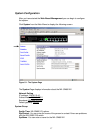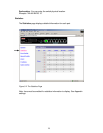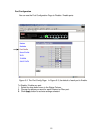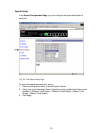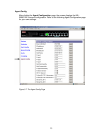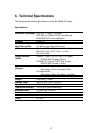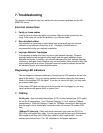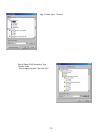
7. Troubleshooting
This section is intended to help you resolve the most common problems on the MIL-
SM801XX series.
Incorrect connections
n Faulty or loose cables
Look for loose or obviously faulty connections. Make sure the connections are
snug. If that does not correct the problem, try a different cable.
n Non-standard cables
Non-standard or incorrectly pinned cables may cause anything from network
collisions to no network connectivity at all. A category 5 cable tester is
recommended during your network installation.
n Improper Network Topologies
It is important to make sure that you have a valid network topology. Common
topology faults include excessive cable length and too many repeaters (hubs)
between end nodes. In addition, you should make sure that your network topology
contains no data path loops. Between any two-end nodes, there should be only one
active cabling path at any time. Data path loops will cause broadcast storms that
will severely impact your network performance.
Diagnosing LED Indicators
You can diagnose common problems by monitoring the LED indicators on the front
panel of the switch. If you are having network connection issues the first place to
check is the switches LED link lights. If you do not have a link light, you may have
an incorrect cable type.
If the power LED does not light up when the power cord is plugged in, you may
have a problem with power outlet, or power cord.
n Cabling
RJ-45 ports - Use unshielded twisted-pair (UTP) or shield twisted-pair (STP) cable
for the RJ-45 connections. Use 100ohms Category 3, 4 or 5 cable for 10Mbps
connections or 100ohms Category 5 cable for 100Mbps connections. Also be sure
that the length of any twisted-pair connection does not exceed 100 meters (328
feet).
100Base-FX fiber port - Fiber multi-mode connector type must use 50/125 or
62.5/125µ multi-mode fiber cable. You can connect two devices up to 2-kilometers.
With single-mode fiber use 9/125µ fiber cable for multi-mode as well. You can
connect two devices from 15 to ~60- kilometers in full duplex operation.
26



